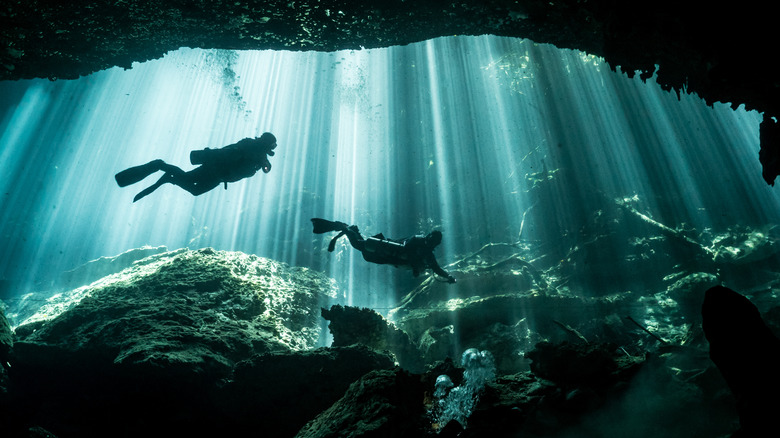The Unassuming New Mexico Lake That's Actually A Death Trap
The human drive to explore extreme environments has led to countless adventures into the unknown, from attempts to summit the tallest and most remote peaks to mapping the depths of the planet's oceans. Underwater realms hold a particularly compelling place in our minds, which is probably why we find things like underwater waterfalls so captivating. But cave diving — one of the most hazardous and alluring pursuits there is for thrill seekers — might just be the pinnacle of dangerous curiosity, combining the challenges of navigating underwater labyrinths with the ever-present risk of drowning or getting trapped.
The Blue Hole of Santa Rosa, a natural swimming hole in New Mexico, has long drawn divers to its waters for just this reason. This bell-shaped lake is roughly 60 feet in diameter but descends 90 feet through clear, cerulean water, making it a dream location for divers. But beneath the lake's serene surface lies a cave system that hides a tragic past. In 1976, two Oklahoma State University students taking part in an open-water diving class strayed from their group and entered the cave system at the lake's bottom. The entrance to the underground passageway, like much of the cave system itself, is precariously narrow and challenging to navigate, even for experienced divers. As a result, the pair ended up losing their lives.
Horrified by the tragedy, the City of Santa Rosa installed a metal grate in the shape of a pipe over the entrance to the cave, followed by the U.S. Army Corps of Engineers dumping two construction trucks' worth of rocks on top of it to ensure such a thing could never happen again. Decades later, though, a team of explorers hatched a daring plan to unearth the entrance and map the entirety of the underwater cave system.
The dangerous quest for discovery
During the retrieval of the bodies of the two student victims, local authorities made incomplete sketches outlining the initial portion of the cave system. Those sketches were all the knowledge that existed on the underwater labyrinth until 2013 when a team from the Advanced Diver Magazine Exploration Foundation undertook an expedition to reopen and map the system in full.
The team, which consisted of seasoned explorers, videographers, and cartographers, managed to clear some of the debris that had been dumped on the cave's entrance. Lead explorer Brent Hemphill even managed to enter the first cave that had been sealed off for years, but due to the presence of a massive boulder preventing him from going any further, the team decided that was all they could accomplish at that point.
Luckily, the team removed so much debris in their effort to enter the cave that it increased the natural flow of artesian water coming up from the cave system, improving the lake's visibility immensely. Blue Hole rests on top of the Ogallala Aquifer, which is how the cave system pumps out 3,000 gallons of water every minute, maintaining the lake's pristine clarity and color.
The cost of underwater exploration
The Advanced Diver Magazine Exploration Foundation team would return to the cave several times over the next few years, eventually mapping it completely. However, the efforts to do so would yet again come at the highest cost. During a multiple-day expedition in 2016, veteran diver Shane Thompson drowned while exploring the cave, having gotten stuck in an unmapped, dead-end offshoot of the underground system.
Blue Hole's underwater cave system terminates roughly 194 feet underground, where water from the aquifer that created it seeps through tons of rock debris at its endpoint. Because of low visibility within the cave and its repeated history of claiming lives, its entry was sealed off once again, the pipe covering the human-sized hole eventually being replaced by a gate during a repair mission by Viking Dives in 2024.
Underwater exploration is a key component of humanity's efforts to understand the world we live in. Without it, we wouldn't have come upon the potentially paradigm-shifting discovery of dark oxygen, among other things. However, it remains one of the most perilous activities that exists and will always come with risks. If you're interested in learning about more watery discoveries, check out the unexpected place we found water beyond Earth.


